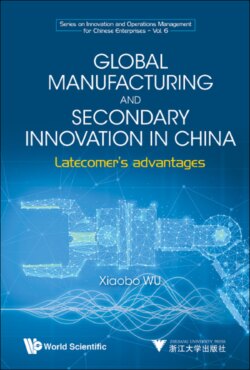Читать книгу Global Manufacturing and Secondary Innovation in China - Xiaobo Wu - Страница 24
На сайте Литреса книга снята с продажи.
1.5 Research intention and structure of this book
ОглавлениеManufacturing industry has played a key role in the four decades of high-speed economic growth after the Reform and Opening-up. In the accelerated globalization of recent years, a number of “tide riders” have sprung up in China’s manufacturing industry. They stand out in both the domestic and international markets and have changed from merely “catching-up” with the leading companies to “surpassing” and “taking the lead” to a certain extent. But at the same time, due to the rising cost of production factors, the international financial crisis and the lack of independent innovation capabilities, etc., China’s entire manufacturing industry is facing a daunting test. To secure the competitive advantages of China’s manufacturing industry in the new competitive global environment and compose another brilliant chapter is the key to China’s sustainable economic development in the new century.
Powered by the torrents of globalization, multinational corporations have adjusted their strategies. Based on their existing business strength, multinational corporations reinforce their innovation efforts and implement globalization strategies to realize their values. This may aggravate the polarization of the rich and the poor. Facing such daunting test, companies of developing countries must recognize that innovation is the fundamental driving force behind economic globalization. In the context of globalization, the innovation process presents new features. It is necessary to explore the innovation issues through analyzing the current initial capacity inadequacy of the latecomer companies in developing countries in the context of economic globalization. In the globalized environment, how can China’s manufacturing industry establish, maintain, consolidate and develop competitive advantages? This is an urgent question that has caught the attention of Chinese scholars and entrepreneurs. It’s also a question pressing for early solutions.
This study aims to apply the theory of technological innovation based on China’s actual situation and the recent findings of international management academia. In view of the new challenges posed by the manufacturing globalization to Zhejiang’s manufacturing companies, studies were conducted on the non-linear relationship and dynamic suitability between the dynamically evolving rules of “secondary innovation” and corporates’ organizational learning modes. Analysis was made on the internal mechanism adopted by Zhejiang’s manufacturing companies to win the “latecomer’s advantages” in globalization process. Such analysis can establish a strategic management framework focused on improving the international competitiveness of China’s manufacturing industry.
In the context of strengthening global integration in the era of information-knowledge economy, the manufacturing industry is undergoing worldwide strategic adjustment and reorganization, to enhance international competitiveness and try to stand out in the face of new historical opportunities. The development of manufacturing industry is a decisive force that determines whether the Chinese economy can continue to develop in the 21st century. From the dynamic perspective, being the key innovation makers in the open system, manufacturing companies need to secure the dynamic suitability between their development strategies and internal and external environments if they want to gain competitive advantages in globalization process, at different development stages and in competitive environments. One of the key factors in achieving this suitability is to promote companies’ secondary innovation and win the latecomer’s advantages through secondary innovation. This is the fundamental way for China’s manufacturing industry to win in the global competition.
The following chapters of this book are organized as follows: Chapter 2 introduces the theoretical background and practical background of the construction and development of the secondary innovation theory; Chapter 3 elaborates on the dynamic model of secondary innovation; Chapter 4 presents the evolution and development of the dynamic theoretical model for secondary innovation; Chapter 5 dwells upon the dynamic pattern of secondary innovation and organizational learning; Chapter 6 focuses upon the cultivation of technological innovation capabilities in the dynamic process of secondary innovation; Chapter 7 is about constructing an organization and management system in the dynamic process of secondary innovation; and Chapter 8 is a summary of the book.
